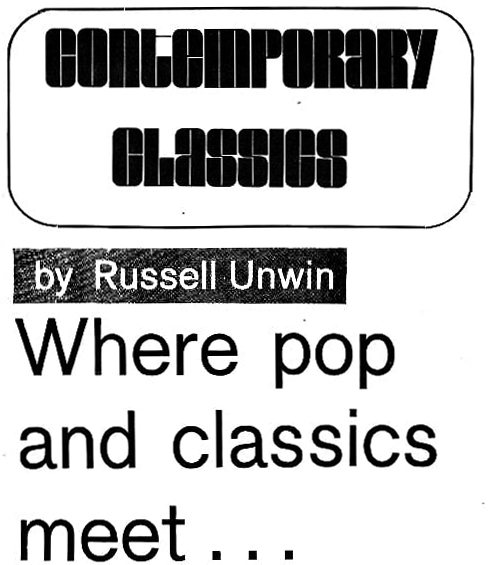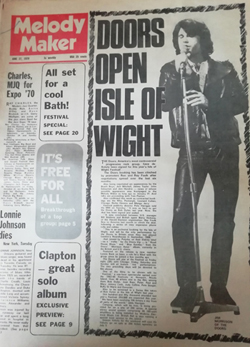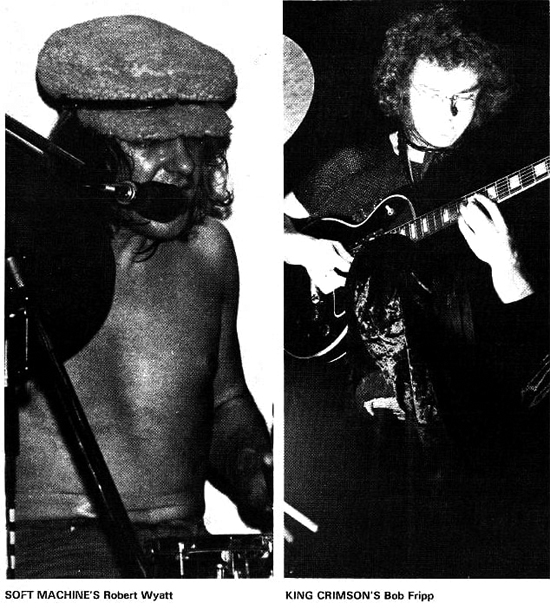UP until now there has been very little to discuss regarding the relationship between the pop music and the classical music of the day. In the past they have been poles apart.
Today, pop music has grown up and become sophisticated; it is not so obviously naive. Classical music too has grown up in a way: it has learned not to take its illustrious forefathers too seriously. It has learned, in short, to do its own thing. So the two worlds have found themselves with much in common.
Experiment
Both spheres of music are characterised by a desire to experiment - experiment to establish new forms and modes of expression. In this there is much interchange between one camp and the other.
Then we have the breaking down of the distinction between composer and performer, in this case the performer becomes the composer and vice-versa; spontaneous improvisation, sometimes based on a strictly organised concept, sometimes on a completely free basis is the order of the day in both fields. Groups of musicians create and resolve their own musical situations on the spot.
Although it may be taken as true that contemporary pop and contemporary classics have so much in common that they must be the same thing, there are still subtle distinctions which keep them regrettably apart. The basis of this distinction is mostly one of function.
The function of the Who, one of the most middle of the road bands around, is to generate power and excitement. The function of Stockhausen is to stimulate and exercise the thoughtful mind. So the distinction is, crudely, between body and mind.
Overlap
These are two extreme examples to illustrate the point. It is the area where the two fields overlap which is most interesting and only just beginning to be effective.
The only two bands which seem to be wholly committed to this area, looking back over the last few months, are Soft Machine and King Crimson.
In live performances and on record Soft Machine have a unique sense of form. Their sets are a continuous tight stream of material which develop constantly and logically, making complete use of different types of sound and all kinds of rhythm.
As a whole the music creates an enigmatic, original character of its own which always maintains a high level of interest. On record the music is the same; each side of the disc becomes an entity in itself, without being a random succession of tunes as in most pop albums.
King Crimson have done the same on their albums, each piece has a special relationship with the record as a whole, making full use of the facilities available within the recording studio. Indeed with Crimson the whole package becomes a tight unity including sleeve design and the words to the songs.
Sound
The lyrical songs on the Crimson albums, although superficially they seem almost Simon and Garfunkel, somehow take on a different meaning in relation to the usually heavy sound of the band. They seem to have found a new function for the traditional song, in the same manner as the Beatles did in "Abbey Road."
The most important aspect of the music of both Soft Machine and Crimson is their readiness to use sound for its own sake. With Soft Machine the echoed vocalisation of Robert Wyatt and Mike Ratledge's organ, with Crimson the tasteful use of the mellotron especially in the " Devil's Triangle " section at their "Poseidon" album.
This puts the two bands in line with the contemporary avant-garde classicists who also have a tendency to use sound for its own sake.
Another band which I must mention in this context is. of course, the Mothers of Invention, who have influenced both Soft Machine and Crimson as well as many other bands. The Mothers music is again intelligently assembled as a whole but with a strong satirical element.
The Mothers satirise pop music of the past to make their own unique contribution to the present. The only trouble with the Mothers is their tendency to be purposefully obscure - being way out for way out's sake. Anyway they are always good for a laugh.
Phase
A big thing has been made recently of amalgamations between pop groups and symphony orchestras. The Nice, and Deep Purple did it. Barclay James Harvest are about to it. This really is a passing phase probably brought on by a shortage of good original ideas.
There is absolutely no future in Jazzing up Bach and the like. The only interesting excursion was Deep Purple's Concerto for Pop group and orchestra which did at least bring two vastly different types of musician together on equal terms on one stage.
Zeppelin
It can be seen then that a true lasting relationship between contemporary pop and contemporary classics can only be made by following the example of groups like Soft Machine and King Crimson. Probably the open proof of this relationship will be made at this year's Proms when Soft Machine play alongside Tim Souster. Roger Smalley and the BBC Symphony on August 13.
Other bands play exciting music on the scene today, but unfortunately much of it is very derivative. For instance. Led Zeppelin are a marvellous band but they only make it with their exciting sound and the way they do their numbers, the same goes for the Who and other heavy bands.
Jon Hiseman's Colosseum deserve a special mention for their uncompromising wedding of pop and jazz, but the roots are still in the blues. Pink Floyd are a band whose instrument play the musicians instead of the other way round.
If contemporary pop is to survive intact as an art form on an equal basis with contemporary classics, it must begin to move away from its origins and establish its own ground. Otherwise we shall have nothing to relieve the monotony of the top thirty.



